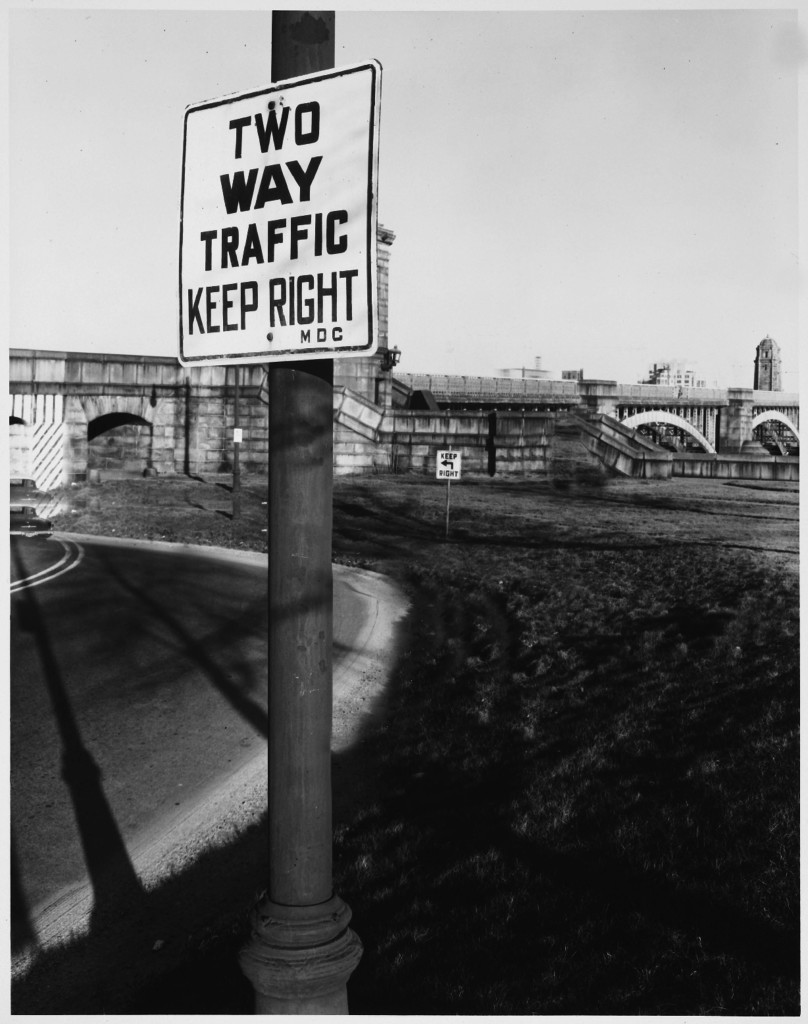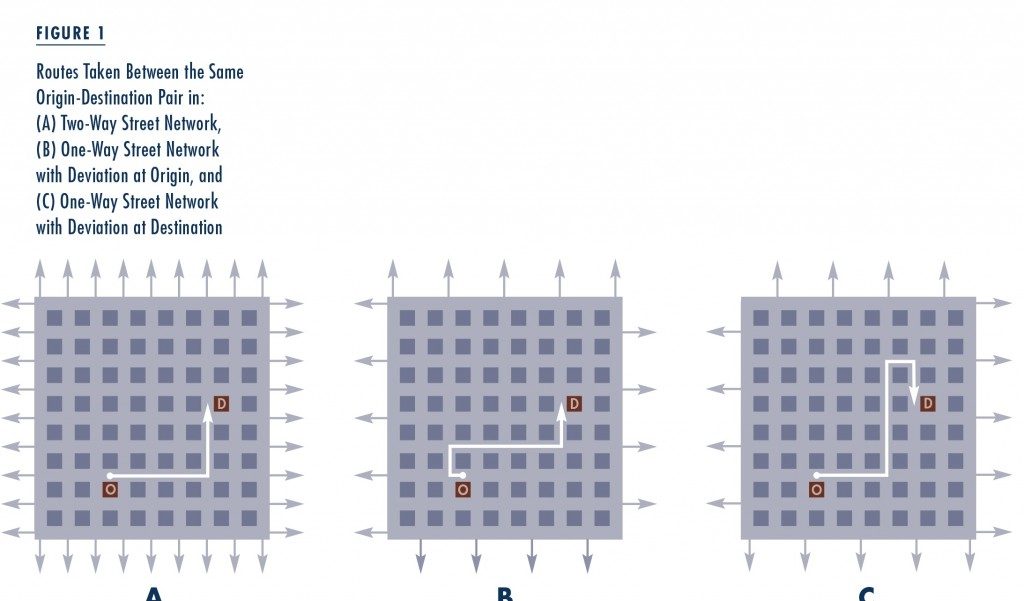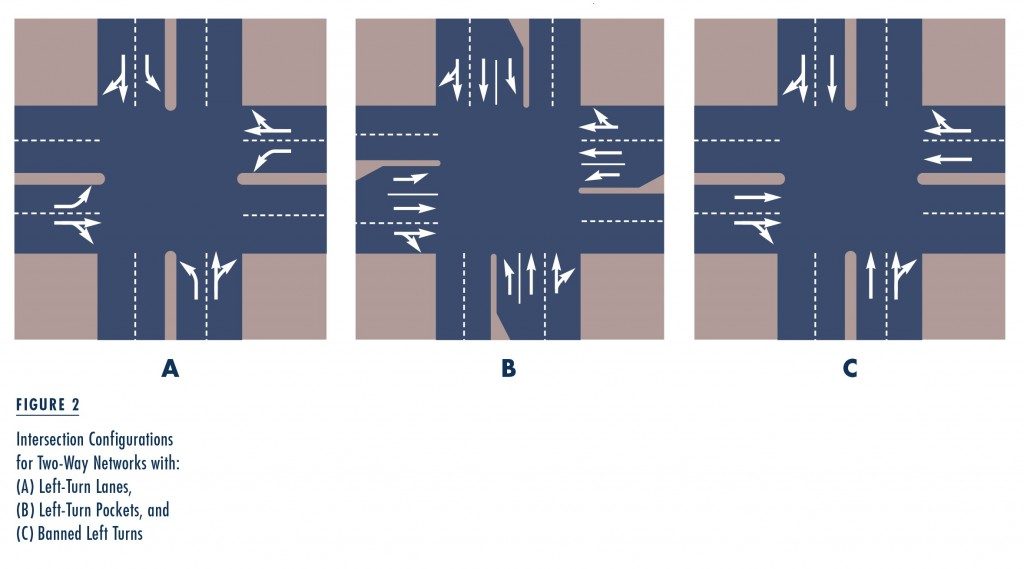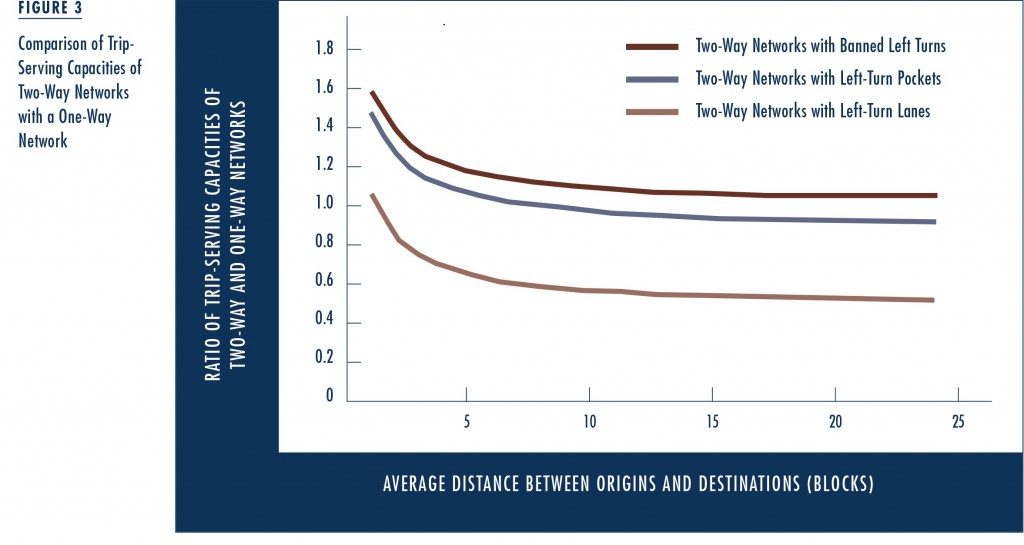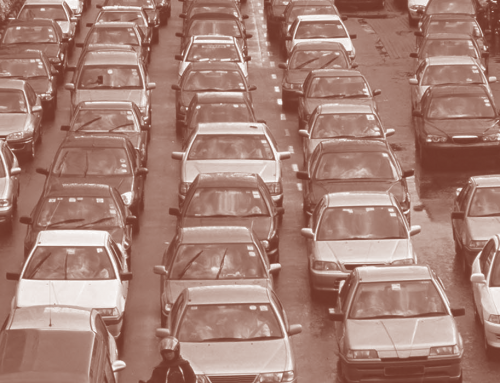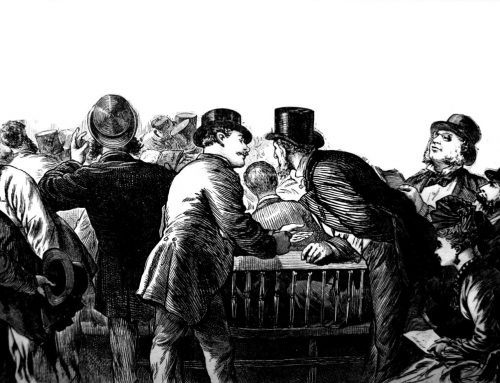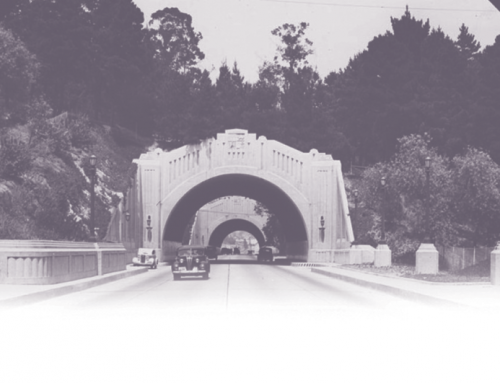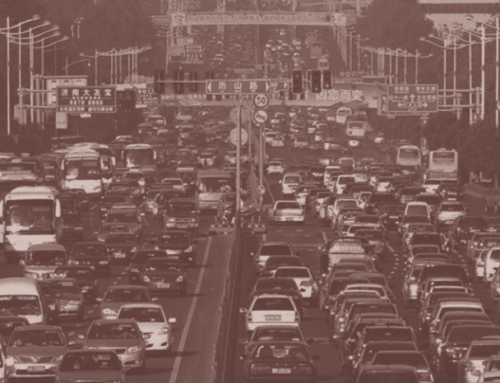One-way streets in downtown areas are receiving a critical look. City officials and urban planners have started a movement to convert downtown street networks from their traditional one-way operation to two-way operation. This effort seems to be largely successful—many cities (e.g., Denver, CO; Dallas and Lubbock, TX; Tampa, FL; Des Moines, IA; Salina, KS; Kansas City, MO; Sacramento, CA) have either recently made or are in the process of making such conversions. These conversions are intended to improve vehicular access and reduce driver confusion. Many additional factors go into this decision, but the general premise is clear: travelers and residents prefer two-way streets for a variety of economic and livability reasons, while traffic engineers and transportation planners believe that one-way streets serve traffic more efficiently.
Our study uses an idealized traffic network model to directly compare the efficiency of one-way and two-way street networks. It finds that two-way streets may serve traffic more efficiently, especially when trips within the network are short.
Two-Way Street Networks Increase Economic Activity and Livability
The current literature on urban street network design stresses that two-way streets create higher levels of economic activity and improve the livability of downtown areas. For example, two-way streets are better for local businesses that depend heavily on pass-by traffic. Additionally, traffic signal timing on two-way streets forces vehicles to stop more frequently than on one-way streets, giving drivers more exposure to local businesses.
Two-way streets have also been found to be safer than one-way streets, for several reasons. Although intersections of two-way streets have more conflicting maneuvers, one-way streets correlate with decreased levels of driver attention. One-way streets also allow higher travel speeds since signal timing results in less frequent stops for vehicles. Pedestrians also prefer crossing two-way streets since drivers tend to travel more slowly on them and vehicular conflicts are more predictable.
A one-way network may prevent drivers from approaching their destination from the most logical direction. This uncertainty can intimidate drivers and, in some cases, make them hesitant to return.
Downtown visitors, whether they arrive by car or public transportation, prefer two-way street networks to one-way street networks because they are less confusing. Visitors driving in a two-way grid network can easily approach their destination from any direction. A one-way network may prevent drivers from approaching their destination from the most logical direction. This uncertainty can intimidate drivers and, in some cases, make them hesitant to return. Likewise, two-way streets make locating the transit stop for a return trip from downtown easier—in almost all cases, the bus stop is simply located across the street. On one-way networks, however, the stop for the return trip is usually on another street, which may confuse visitors and cause them to get lost.
Additionally, two-way street networks allow drivers to take the most direct routes from origin to destination. Consider, for example, the trip shown in Figure 1a between origin O and destination D. In a two-way network (shown by the arrows that denote travel direction), the driver can take the most direct path from O to D. Compare this route to the same trip on a one-way network, as shown in Figures 1b and 1c. The driver may have to travel some additional distance at either the origin (as in Figure 1b), destination (as in Figure 1c), or both. Thus, the use of one-way street networks increases the average driving distance between any paired origin-destination points and will result in more vehicle miles traveled (VMT). Increased VMT means increased fuel consumption, emissions, and exposure to accidents.
One-Way Street Networks Increase Vehicle Flow
One-way street networks do have one critical advantage over two-way street networks: they eliminate conflicting left-turn maneuvers at intersections. This is critical because left turns reduce maximum vehicle flows at intersections. For example, left-turning vehicles that are mixed with through traffic must wait for a gap in the opposing traffic and can block upstream vehicles waiting to go through. Separate lanes can segregate left-turning vehicles from other vehicles to reduce this blocking, but this strategy also reduces the amount of space available for the remaining vehicles to move through the intersection. Dedicated left-turn signals can be used to eliminate blocking, but their presence leads to more complicated signal timing and increases the amount of time wasted for vehicle movement at the intersection. Since intersections limit maximum network flows, it follows that one-way street networks can serve higher maximum network flows (i.e., have higher vehicle-moving capacity) than two-way street networks.
Reduced vehicle capacities lower network efficiency.
Opponents of converting one-way streets to two-way operation often cite this decrease in vehicle-moving capacity (in addition to cost and feasibility). Although two-way streets can increase prosperity and livability, decision makers fear that the loss in vehicle throughput will result in longer and more congested peak periods, lower average vehicle speeds, and increased vehicular delay. Thus, reduced vehicle capacities lower network efficiency. Worse yet, congestion arising from the loss in vehicle-moving capacity can cause people to avoid downtown and may contribute to its decline as a center of economic and recreational activity.
Trip-Serving Capacity: A Better Metric of Network Efficiency
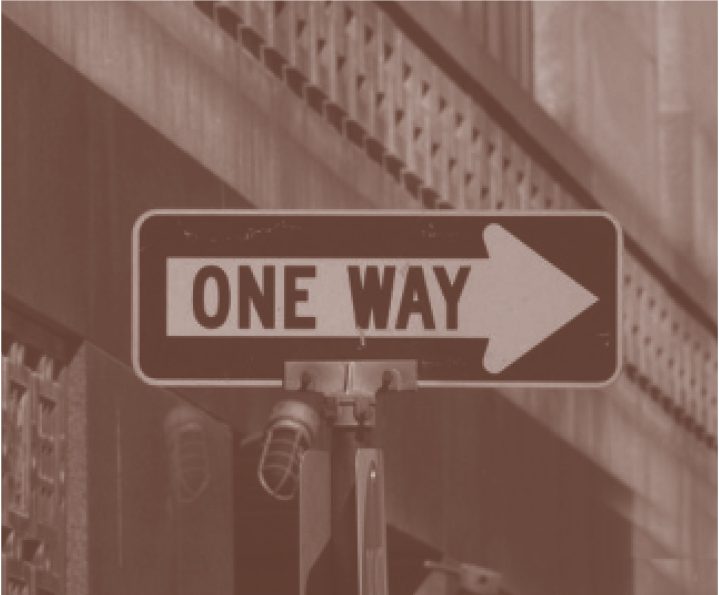 The ability to move many vehicles does not reflect the ultimate objective of any transportation network. The goal is to allow people to reach their destinations as quickly as possible. The maximum rate at which people reach their destinations, also known as the network’s trip-serving capacity, more accurately captures this objective. All else equal, a network with a higher trip-serving capacity will serve vehicle trips with less delay.
The ability to move many vehicles does not reflect the ultimate objective of any transportation network. The goal is to allow people to reach their destinations as quickly as possible. The maximum rate at which people reach their destinations, also known as the network’s trip-serving capacity, more accurately captures this objective. All else equal, a network with a higher trip-serving capacity will serve vehicle trips with less delay.
Therefore, even though current research and conventional wisdom suggest that one-way street networks are more efficient than their two-way counterparts, we show that one-way networks are sometimes less efficient because they restrict the rate at which people reach their destinations. When this is the case, there is a greater incentive to convert traditional one-way street networks to two-way operation.
Network Comparison
We can directly compare the trip-serving capacities of various two-way and one-way networks. The two-way street networks differ in their treatment of conflicting left turns at intersections. Here, we consider three treatments for a network with two travel lanes in each direction. Figure 2 shows the intersection configurations for these networks. Table 1 summarizes the advantages and disadvantages of these three treatments.
The trip-serving capacities of these networks vary based on factors such as demand distribution, signal timing at the intersections, and driver routing schemes. To simplify the analysis, we compare the networks under ideal conditions, which include uniform travel patterns, dedicated left-turn signals that are timed to serve the existing left-turn demand, and the most direct driver routing. These ideal conditions facilitate an analytical solution to the trip-serving capacities of the different networks, but the results of this analysis also apply to real-world conditions where these assumptions are relaxed.
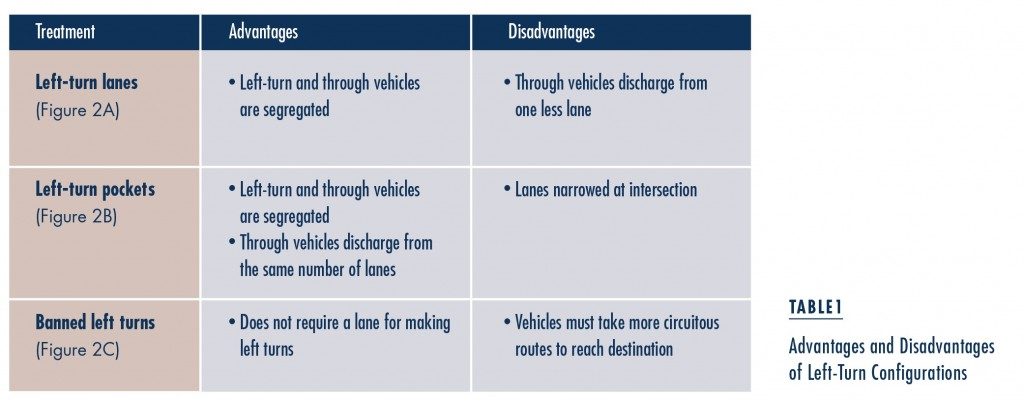 A network’s trip-serving capacity turns out to be a ratio of two quantities: its vehicle-moving capacity and the average trip length. The number of vehicles that can move through an intersection during a signal cycle determines the vehicle-moving capacity. Applying probability theory to the network geometry can help us determine the average trip length by determining how much farther vehicles must travel given the movement restrictions. Both quantities, and thus the trip-serving capacity of the network, turn out to be a function of two key parameters: 1) the average distance between origins and destinations in the network; and, 2) the amount of time wasted at left-turn signals. Figure 3 shows the ratio of the trip-serving capacities for the two-way street networks compared to the one-way street network for different values of these variables. This ratio measures the relative efficiency of a two-way network compared to a one-way network. Values greater than one imply that the two-way network serves trips at a higher rate, while values less than one imply that the one-way network is superior.
A network’s trip-serving capacity turns out to be a ratio of two quantities: its vehicle-moving capacity and the average trip length. The number of vehicles that can move through an intersection during a signal cycle determines the vehicle-moving capacity. Applying probability theory to the network geometry can help us determine the average trip length by determining how much farther vehicles must travel given the movement restrictions. Both quantities, and thus the trip-serving capacity of the network, turn out to be a function of two key parameters: 1) the average distance between origins and destinations in the network; and, 2) the amount of time wasted at left-turn signals. Figure 3 shows the ratio of the trip-serving capacities for the two-way street networks compared to the one-way street network for different values of these variables. This ratio measures the relative efficiency of a two-way network compared to a one-way network. Values greater than one imply that the two-way network serves trips at a higher rate, while values less than one imply that the one-way network is superior.
In Figure 3 the two-way networks that allow left turns have higher trip-serving capacities for shorter trip lengths. When trip lengths are short, the additional circuity of one-way networks is so damaging that simpler signal timing at the intersection (and higher vehicle-moving capacities) cannot compensate for the additional travel distance. When trips are longer, however, simpler signal timing does compensate for the additional travel required by the one-way network. Since average trip length should be proportional to the size of the downtown area, a one-way to two-way conversion of a downtown network may actually increase the network’s ability to serve trips in smaller cities. Figure 3 also shows that even if trips are long, the two-way networks with left-turn pockets can provide trip-serving capacities that are just 10 percent lower than one-way networks. The critical trip length that separates “short” and “long” trips is a function of the amount of time wasted at dedicated left-turn signals. As more time is wasted at dedicated left-turn signals, this critical trip length decreases.
The critical trip length that separates “short” and “long” trips is a function of the amount of time wasted at dedicated left-turn signals.
Notably, the two-way network with banned left turns always has a higher trip-serving capacity even when trips are long. Both strategies provide the same vehicle-moving capacity (since both eliminate conflicting turning maneuvers), but the two-way network with banned left turns imposes less circuitous routes than the one-way network. In fact, the additional travel distance required in a one-way network is at least twice that of a two-way network with banned left turns. This makes physical sense since one-way networks are more restrictive and ban more vehicular movements. Thus, if left turns are banned at the intersections, converting a one-way network to two-way network operation can always increase the ability of the network to serve trips even for larger cities with longer average trip lengths.
Conclusion
Contrary to conventional wisdom and design handbooks, two-way networks are often more efficient than one-way networks. Even though two-way networks may provide lower vehicle-moving capacities, they can, in some cases, serve trips at a higher rate. This trip-serving capacity is a better metric for predicting network performance during peak periods. When trips are short, two-way networks that allow conflicting turning maneuvers have higher trip-serving capacities than one-way networks because the additional circuity in one-way networks offsets the more efficient intersection control. Two-way networks are more competitive as the length of the signal cycle increases. Additionally, two-way networks that ban left turns can always serve trips at a higher rate. While both strategies eliminate conflicting turning maneuvers, two-way networks with banned left turns impose less circuity than one-way networks.
Regardless of the size of the city, however, a one-way to two-way street conversion should always increase the efficiency of downtown networks.
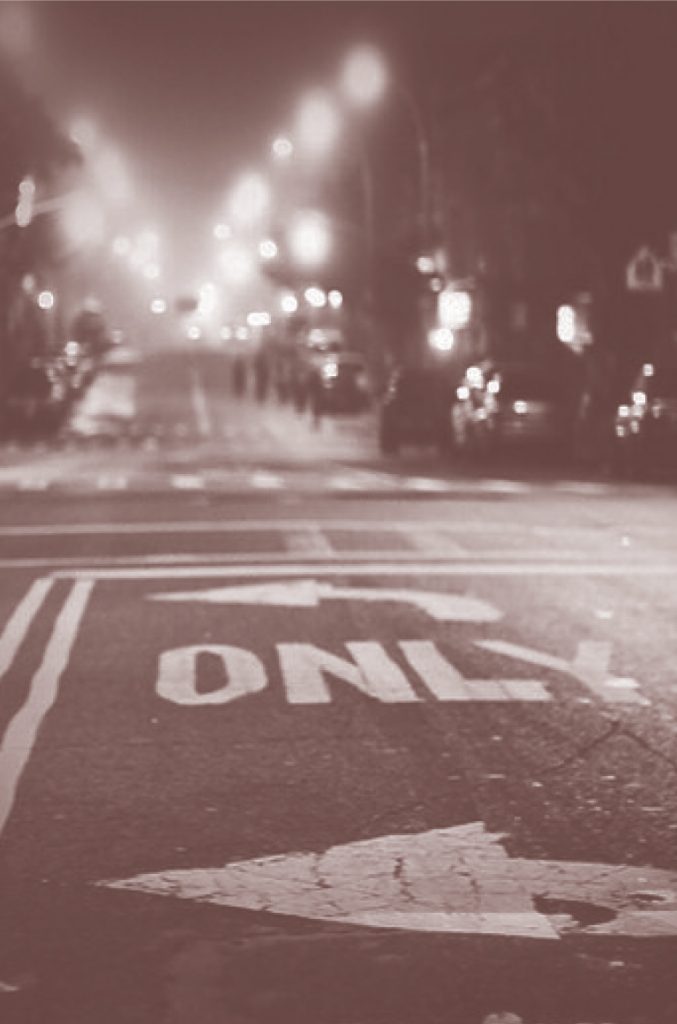 When they consider converting to two-way streets, urban planners and traffic engineers should examine the average trip length within the network. Intuition suggests that average trip lengths tend to be proportional to the size of the downtown—larger downtowns should have longer trip lengths. Smaller downtowns should thus carefully examine the time wasted when providing dedicated left-turn signals to determine what type of two-way network configuration to use. Since the wasted time decreases with average cycle lengths, smaller cities should accommodate left turns only when cycle lengths are long, and should ban left turns when cycle lengths are short. Larger downtowns, however, should also convert to two-way operation but ban left turns at intersections. Regardless of the size of the city, however, a one-way to two-way street conversion should always increase the efficiency of downtown networks. Since residents prefer two-way street networks for a variety of reasons, converting a one-way street network to two-way operation can improve both the efficiency and livability of cities.
When they consider converting to two-way streets, urban planners and traffic engineers should examine the average trip length within the network. Intuition suggests that average trip lengths tend to be proportional to the size of the downtown—larger downtowns should have longer trip lengths. Smaller downtowns should thus carefully examine the time wasted when providing dedicated left-turn signals to determine what type of two-way network configuration to use. Since the wasted time decreases with average cycle lengths, smaller cities should accommodate left turns only when cycle lengths are long, and should ban left turns when cycle lengths are short. Larger downtowns, however, should also convert to two-way operation but ban left turns at intersections. Regardless of the size of the city, however, a one-way to two-way street conversion should always increase the efficiency of downtown networks. Since residents prefer two-way street networks for a variety of reasons, converting a one-way street network to two-way operation can improve both the efficiency and livability of cities.
This article is adapted from the longer version, “Analytical Capacity Comparison of One-Way and Two-Way Signalized Street Networks,” originally published in Transportation Research Record.
Further Readings
Carlos F. Daganzo. 2007. “Urban Gridlock: Macroscopic Modeling and Mitigation Approaches,” Transportation Research Part B, 41 (1): 49–62.
Vikash V. Gayah and Carlos F. Daganzo. 2012. “Analytical Capacity Comparison of One-Way and Two-Way Signalized Street Networks,” Transportation Research Record, Forthcoming.
Richard W. Lyles, Chessa D. Faulkner, and Ali M. Syed. 2000. Conversion of Streets from One-Way to Two-Way Operation, East Lansing: Michigan State University, Department of Civil and Environmental Engineering.
G. Wade Walker, Walter M. Kulash, and Brian T. McHugh. 2000. “Downtown Streets: Are We Strangling Ourselves on One-Way Networks?” Transportation Research Circular, 501 (F-2): 1–18.

